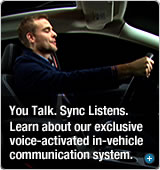 Bringing the Road into the Lab
Bringing the Road into the Lab

Our $10 million driving simulator laboratory helps our researchers study driver workload and distraction issues related to new in-vehicle electronic devices.
Dubbed VIRTTEX for VIRtual Test Track EXperiment, the Ford Research Laboratory simulator allows scientists to duplicate highway and city driving in a safe and controlled laboratory setting.
The facility allows researchers to measure a driver's ability to cope with common traffic situations while using cell phones, navigation systems and other in-car electronic equipment.
Welcome to the Virtual Road
VIRTTEX works by using advanced computer graphics to create a virtual driving environment. Participants sit behind the wheel of a specially instrumented vehicle bolted inside the simulator, and drive according to the test instructions. This virtual environment is enhanced through steering wheel feedback and realistic sound cues.
During a simulated drive, researchers can measure the driver's ability to cope with an array of traffic situations while using in-vehicle electronic equipment. In addition to collecting vehicle data on steering, speed control and braking, five in-car cameras record the road scene and the driver's hand, eye and foot movement.
The advantage of using a simulator instead of observing drivers on the road is that conditions can be carefully controlled and reproduced, allowing us to conduct back-to-back comparisons and gain more accurate and insightful results.
Simulated Experience, Real Insights
Besides helping us study driver behaviors, the simulator also acts as a world-class human factors laboratory. Observing users in the simulator, we learn what customers want in areas related to driving dynamics, active safety, vehicle internet access, automotive multimedia and powertrain drivability.
Driver Distraction Test
Ever wonder how distracting talking on your cell phone while you're driving is? To find out, our researchers used VIRTTEX to conduct a series of driver distraction studies.
From the results of our tests, which analyzed the length of time it took a participant to complete a task, such as adjust the temperature or retrieve a voicemail, we found significant variation between teenagers (16 to 18 years old) and adults (25 to 66 years old). Younger drivers accomplished tasks quickly; older drivers took longer.
The results of our research showed hand-held voicemail retrieval and hand-held phone dialing are distracting to adult drivers. To make in-vehicle phone use safer, manufacturers need to design systems to make phone use less distracting. And to educate drivers about the hazards of driving and dialing, driver education curricula should be revised.
Taking Action to Keep Teen Drivers Safe
We've already done something to address the finding of our driver distraction study. Working with the Governors Highway Safety Association, we developed the Driving Skills for Life program, an education program aimed at improving teen driver training that will reach all 20,000 U.S. high schools this year.
Driving Skills for Life includes a video and brochures that discuss distraction and stress on the roadways. It also encourages teens to keep cell phones turned off while they are behind the wheel.
Our researchers have also teamed up with the federal government, General Motors, Delphi Automotive, and leading universities to study how technology might help manage distraction while driving. The program, called SAVE-IT, is a three-year research effort that looks at so-called workload managers.
More Information
For more information about our teen driver education program, visit the Driving Skills for Life website.

